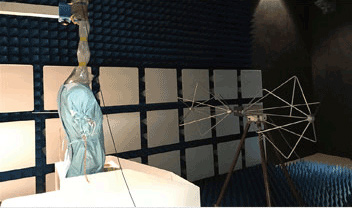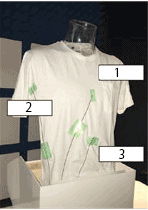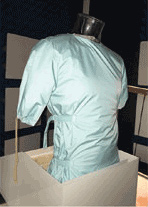MRI Protector Menu(Tap to display menu)
Medical Devices and Hygiene Products
Various test data
Test Data
● MRI protector electromagnetic shielding performance evaluation test
- Exam Date:June 7, 2019 9:00~17:00
- Reporter:Osaka Industrial Technology Research Institute, a local independent administrative institution
- theme:"Evaluation of the shielding characteristics of electromagnetic protective clothing using a body-shaped phantom" Electromagnetic waves of 64MHz and 128MHz are irradiated from various angles to verify the electromagnetic shielding performance.
- Investigation: The electromagnetic shielding performance of the MRI protector was 76% on average at 72 different points on the body surface when not worn and after wearing, and the amount of radiation exposure to the human body was reduced compared to when not worn. Based on a report by the Osaka Industrial Technology Research Institute (local government).

Conducting electromagnetic shielding performance tests using a human body phantom
● MRI protector temperature rise evaluation test
- Exam Date:July 3, 2019 9:00~17:00
- Reporter:Osaka Industrial Technology Research Institute, a local independent administrative institution
- theme:"Evaluation of temperature rise in MRI protectors due to exposure to high-output electromagnetic waves" Copper-constantan thermocouple measurement terminals were attached to the epigastric region, umbilicus, and right armpit of a human-body phantom, and 64 MHz and 128 MHz electromagnetic waves were irradiated at maximum output for 360 seconds, and the temperature rise was observed.
- Investigation: No temperature rise was observed in the MRI protector. The risk of temperature rise due to electromagnetic waves is considered to be small. Based on a report by the Osaka Industrial Technology Research Institute (local government)
Thermocouple attached to shirt

1.Epigastric 2.Right armpit 3.abdomen
↓Apply the MRI protector

MRI Protector Clinical Use Status
● Frequency and status of clinical use of MRI protectors by product
Between October 2017 and June 2019, this product was used during 238 MRI examinations with 1.5T MRIs and 563 with 3.0T MRIs. There were zero reports of abnormalities, except for one case where the specified wearing method was not followed.
| MRI Protector Type | Number and percentage |
|---|---|
| Part numberMPVT01 Vest & neck (chest and neck) Mainly used for patients with stents and sternum wires during head examinations |
413 Results(46.93%) |
| Part numberMPRS01 Roll sheet A (for arms and legs) Mainly used for head and abdominal examinations for patients with total hip replacement (THR), total knee replacement (TKR), metal wrist braces, and ring wearers (also useful for folding artifacts) |
252Results(28.64%) |
| Part numberMPMT01 Mittens (for hands, feet, and fingers) Mainly used for head and abdominal examinations for those wearing metal finger restraints, rings, or nails |
48Results(5.45%) |
| Part numberMPPT01 Pants (for lower legs) Mainly used for head examinations of patients with total hip replacement (THR) and abdominal stents |
157Results(17.84%) |
| Part numberMPNG Neck guard (for neck) used alone Used for patients with cervical stents during breast examinations |
10Results(1.14%) |
MRI Protector Related Conference Presentation 1
Sumitomo Hospital Radiological Technology Department and our company announced joint research
① September 9, 2016 44th Annual Meeting of the Japanese Society for Magnetic Resonance in Medicine
● Examination of RF shielding effect using commercially available electromagnetic wave shielding materials in MRI
<Presenter>
Masashige Taniguchi, Tatsuya Kuwagaki, Toshihiko Nishida, Hidekazu Shinkawa, Daichi Shimokawa, Akira Tamada, Department of Radiological Technology, Sumitomo Hospital, General Incorporated Foundation, Hideki Matsui, Medical Aid Co., Ltd.
MRI examinations are carried out under strict safety management, however, one important high-risk issue during an MRI scan is the problem of heat generation from metal inside the body.
The heat generation is caused by RF waves (electromagnetic waves of 64 MHz or 128 MHz) emitted from the MRI, and we investigated and verified the RF wave shielding effect of carbon fiber electromagnetic wave shielding materials and silver fiber electromagnetic wave shielding materials, which block and reflect these waves.
As a result of the investigation and verification, it was found that silver fiber electromagnetic shielding material has a higher affinity with the human body than carbon fiber electromagnetic shielding material, is highly flexible, does not pose a risk of scattering dust, and is safe and easy to handle.
Furthermore, it was concluded that silver fiber electromagnetic wave shielding material has high heat dissipation properties due to its honeycomb structure, and because it is a diamagnetic material, it is suitable as an electromagnetic wave shielding material for MRI.
● Application of electromagnetic wave protective clothing for capsule endoscopy in head MRI field
<Presenter>
Masashige Taniguchi, Tatsuya Kuwagaki, Toshihiko Nishida, Hidekazu Shinkawa, Daichi Shimokawa, Akira Tamada, Department of Radiological Technology, Sumitomo Hospital, General Incorporated Foundation, Hideki Matsui, Medical Aid Co., Ltd.
An electromagnetic wave protective suit for capsule endoscopes (hereinafter referred to as "protective suit") made of commercially available silver fiber electromagnetic wave shielding material was placed on the torso of the phantom, and MRI imaging of the head was performed.
As a result of the experiment, they succeeded in attenuating RF waves in areas other than the head, and discovered the possibility of preventing heat generation in metal inside the body and the effects of implantable cardiac devices.
Furthermore, an electric field measuring probe was inserted into the dummy and electromagnetic waves of 64 MHz or 128 MHz were irradiated, and the electric field strength was measured and compared when the protective suit was "not worn" and when it was "worn." As a result, a reduction effect of around 80% was confirmed.
Protective clothing is thought to reduce various risks for staff involved in MRI examinations and also to be useful in reducing the physical and mental stress experienced by patients.
MRI Protector Related Conference Presentation 2
② April 13, 2017 73rd Annual Meeting of the Japanese Society of Radiation Technology
「Verification of the effect of electromagnetic wave protective clothing for capsule endoscopy in the head MRI region」
<Presenter>
Masashige Taniguchi, Tatsuya Kuwagaki, Toshihiko Nishida, Hidekazu Shinkawa, Daichi Shimokawa, Akira Tamada, Department of Radiological Technology, Sumitomo Hospital, General Incorporated Foundation, Hideki Matsui, Medical Aid Co., Ltd.
Following the 44th Magnetic Resonance in Medicine Conference, we analyzed the SAR of each tissue in the head and neck region when a protective suit was worn on the torso of a phantom, and also measured SAR and B+rms because there was a risk of an effect on the reflected power in the RF amplifier. The measurement results showed that the effect of signal attenuation due to RF wave shielding by the torso was minor, even when a head examination was performed while wearing protective clothing.
These results suggest that by wearing protective clothing, it is possible to avoid the risk of fever and provide safe MRI examinations, even for patients with metal implanted in their bodies.
● 「Relationship between the size of the opening in electromagnetic wave protective clothing for capsule endoscopy and the RF wave attenuation curve」
<Presenter>
Tatsuya Kuwagaki, Masashige Taniguchi, Toshihiko Nishida, Hidekazu Shinkawa, Daichi Shimokawa, Akira Tamada, Department of Radiological Technology, Sumitomo Hospital, General Incorporated Foundation, Hideki Matsui, Medical Aid Co., Ltd.
Currently, during MRI examinations, patients with a risk of fever, such as those with cardiac stents or sternum wires, are required to wear protective clothing to prevent RF waves from heating metals in the body. This protective clothing is capable of blocking RF waves from the neck to both upper limbs and the torso, and is designed to prevent RF waves from entering by tightening strings at the openings of the collar, cuffs, and hem to close gaps. However, it has been suggested that the shielding efficiency decreases as the opening becomes physically larger, and if there is a target metal in the body near the opening, there is a risk that RF waves will reach it, increasing the risk of fever.
Therefore, we calculated the RF wave attenuation curve for each size of the opening and considered the effective shielding distance. As a result, we confirmed that for both 1.5T and 3.0T devices, if there is a metal target inside the body near an opening in the protective suit, it is possible to prevent the RF waves from reaching the target by maintaining a distance of at least 20.46 mm, which is the average effective shielding distance.
※The electromagnetic radiation protective clothing for capsule endoscopes and the MRI protector used in the conference presentation are electromagnetic radiation protective clothing that use the same silver fiber and have the same performance. The MRI protector is a newly developed product that has been improved in terms of its shape, durability, handling method, etc., according to the purpose of MRI examination.
Mechanism of electromagnetic wave protection and examples of its use

